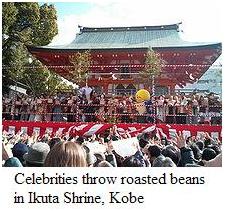Introduction
As one of the Developed countries in the world, Japan is quite well-known for its technologies, etc. For example, you might have or have not heard about PSP from Sony, Android from Samsung, Asimo (the humanoid) which was released by Honda, and many more. There are a lot of Japan’s technologies spread out through the whole world and you probably be using one right now unconsciously. But, let’s skip aside these details about technologies and let’s take a look a little deeper towards Japanese’ cultures.
It is quite rude just to take a look at people only from his/her external appearance without knowing his/her internal appearance. By using the same assumption, we want people to take a closer look on this country, not just from the side they know. Also, I think it is a part of the nature that something becomes famous because of a recommendation from someone else (just a little promotion, don’t take it too seriously ^.^).
What Is Setsubun?
 Just a few days to go and we will reach February, the month where this festival will come to play. Setsubun (節分, bean-throwing festival or bean-throwing ceremony) is a festival held on February 3 or 4, exactly one day before the start of spring season according to the Japanese Lunar Calendar. Originally, this festival or ceremony is held the day before the beginning of each season in Japan. Setsubun literally means “seasonal division”, but usually the term refers to the spring Setsubun, properly called Risshun (立春), which is celebrated as part of the spring festival (春祭, haru matsuri).
Just a few days to go and we will reach February, the month where this festival will come to play. Setsubun (節分, bean-throwing festival or bean-throwing ceremony) is a festival held on February 3 or 4, exactly one day before the start of spring season according to the Japanese Lunar Calendar. Originally, this festival or ceremony is held the day before the beginning of each season in Japan. Setsubun literally means “seasonal division”, but usually the term refers to the spring Setsubun, properly called Risshun (立春), which is celebrated as part of the spring festival (春祭, haru matsuri). This Setsubun is accompanied by a special ritual to cleanse away all the evil from the former year and drive away disease-bringing evil spirits for the year to come. This special ritual is called Mamemaki (豆撒き).
Mamemaki (豆撒き)
Mamemaki (Bean-Throwing) is usually performed by the toshiotoko (年男) of the household (i.e., the male who was born on the corresponding animal year on the Chinese zodiac), or else the male head of the household. Roasted soybeans (called fuku mame (福豆)) are thrown either out the door or at a member of the family wearing an Oni (demon or ogre) mask, while the throwers chant "Oni wa soto! Fuku wa uchi!" (鬼は外! 福は内!). The words roughly translate to "Demons out! Luck in!" The beans are thought to symbolically purify the home by driving away the evil spirits that bring misfortune and bad health with them. Then, as part of bringing luck in, it is customary to eat roasted soybeans, one for each year of one's life, and in some areas, one for each year of one's life plus one more for bringing good luck for the year to come.
Other Practices
At Buddhist temples and Shinto shrines all over the country, there are celebrations for Setsubun. Priests and invited guests will throw roasted soy beans (some wrapped in gold or silver foil), small envelopes with money, sweets, candies and other prizes. In some bigger shrines, even celebrities and sumo wrestlers will be invited; these events are televised nationally. Many people will come, and the event turns wild, with everyone pushing and shoving to get the gifts tossed from above.
It is customary now to eat uncut makizushi called Eho-Maki (恵方巻) (lit. "lucky direction roll") in silence on Setsubun while facing the yearly lucky compass direction, determined by the zodiac symbol of that year. Charts are published and occasionally packaged with uncut makizushi during February. Some families will also put up small decorations of sardine heads and holly leaves on their house entrances so that bad spirits will not enter.
